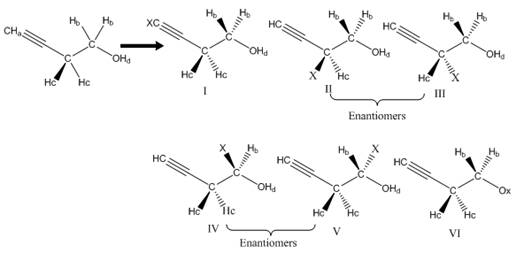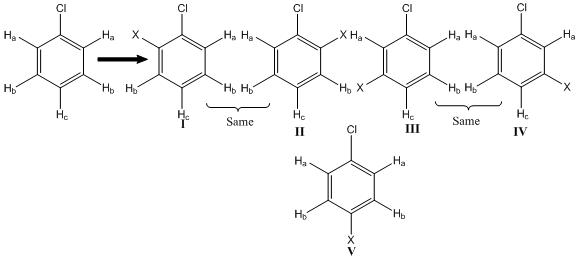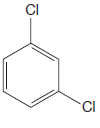
Concept explainers
(a)
Interpretation:
How many chemically distinct H atoms are in the given molecule is to be determined.
Concept introduction:
Sometimes, it is not immediately obvious whether certain hydrogen atoms in a molecule are chemically distinct. In such cases, the chemical distinction test is used. Chemical distinction test is a test in which the complete structure of the molecule is to be drawn in which and only the hydrogen atom is replaced by an imaginary “X” atom. There should be one X-substituted molecule for each hydrogen atom being tested. If the chemical distinction test yields enantiomers, then the corresponding hydrogen atoms are said to be enantiotopic. If the test yields diastereomers, then the corresponding hydrogen atoms are said to be diastereotopic.
Answer to Problem 16.8P
There are two types of chemically distinct H atoms in the given molecule.
Explanation of Solution
The given molecule is:

There are five H atoms in the above compound. These H atoms are not easily identified whether they are distinct or similar. Thus, the chemical distinction test is used here.
All H atoms in the compound are replaced by “X”; all possible structures are as shown below:

Molecules I and II are enantiomers i.e. mirror images of each other. According to chemical distinction test, these H atoms are not chemically distinct. Molecules I/II and III are constitutional isomers, these H atoms are chemically distinct. Therefore, there are two distinct types of protons, one for
Number of chemically distinct H atoms in the given molecule is determined using a chemical distinction test.
(b)
Interpretation:
How many chemically distinct H atoms are in the given molecule is to be determined.
Concept introduction:
Sometimes, it is not immediately obvious whether certain hydrogen atoms in a molecule are chemically distinct. In such cases the chemical distinction test is used. Chemical distinction test is a test in which the complete structure of the molecule is to be drawn in which and only the hydrogen atom is replaced by an imaginary “X” atom. There should be one X-substituted molecule for each hydrogen atom being tested. If the chemical distinction test yields enantiomers, then the corresponding hydrogen atoms are said to be enantiotopic. If the test yields diastereomers, then the corresponding hydrogen atoms are said to be diastereotopic.
Answer to Problem 16.8P
There are four types of chemically distinct H atoms in the given molecule.
Explanation of Solution
The given molecule is:

There are six H atoms in the above compound. These H atoms are not easily identified as distinct or similar. Thus, the chemical distinction test is used here.
All H atoms in the compound are replaced by “X”; all possible structures are as shown below:

Molecules I, II/III, IV/V, and VI are constitutional isomers. According to chemical distinction test, these H atoms are chemically distinct. Molecules II and III also IV and V are enantiomers; these H atoms are not chemically distinct according to the test. Thus, there are total four types of chemically distinct protons in the given molecule b.
Number of chemically distinct H atoms in the given molecule are determined using chemical distinction test.
(c)
Interpretation:
How many chemically distinct H atoms are in the given molecule is to be determined.
Concept introduction:
Sometimes, it is not immediately obvious whether certain hydrogen atoms in a molecule are chemically distinct. In such cases the chemical distinction test is used. Chemical distinction test is a test in which the complete structure of the molecule is to be drawn in which and only the hydrogen atom is replaced by an imaginary “X” atom. There should be one X-substituted molecule for each hydrogen atom being tested. If the chemical distinction test yields enantiomers, then the corresponding hydrogen atoms are said to be enantiotopic. If the test yields diastereomers, then the corresponding hydrogen atoms are said to be diastereotopic.
Answer to Problem 16.8P
There are three types of chemically distinct H atoms in the given molecule.
Explanation of Solution
The given molecule is:

There are five H atoms in the above compound. These H atoms are not easily identified as distinct or similar. Thus, the chemical distinction test is used here.
All H atoms in the compound are replaced by “X”; all possible structures are as shown below:

Molecules I and II, and also III and IV are the same molecules. Molecules I/II, III/IV, and V are consititutional isomers. These H atoms are distinct according to the chemical distinction test. Therefore, there are three types of chemically distinct H atoms in the given molecule c.
Number of chemically distinct H atoms in the given molecul, are determined using chemical distinction test.
(d)
Interpretation:
How many chemically distinct H atoms are in the given molecule is to be determined.
Concept introduction:
Sometimes, it is not immediately obvious whether certain hydrogen atoms in a molecule are chemically distinct. In such cases the chemical distinction test is used. Chemical distinction test is a test in which the complete structure of the molecule is to be drawn in which and only the hydrogen atom is replaced by an imaginary “X” atom. There should be one X-substituted molecule for each hydrogen atom being tested. If the chemical distinction test yields enantiomers, then the corresponding hydrogen atoms are said to be enantiotopic. If the test yields diastereomers, then the corresponding hydrogen atoms are said to be diastereotopic.
Answer to Problem 16.8P
There are three types of chemically distinct H atoms in the given molecule.
Explanation of Solution
The given molecule is:

There are four H atoms in the above compound. These H atoms are not easily identified s distinct or similar. Thus, the chemical distinction test is used here.
All H atoms in compound are replaced by “X”; all possible structures are as shown below:

Molecules II and III are the same molecule. Molecules I, II/III and IV are constitutional isomers. According to the chemical distinction test, these H atoms are distinct. Therefore, there are three types of chemically distinct H atoms in the given molecule d.
Number of chemically distinct H atoms in the given molecule is determined using the chemical distinction test.
(e)
Interpretation:
How many chemically distinct H atoms are in the given molecule is to be determined.
Concept introduction:
Sometimes, it is not immediately obvious whether certain hydrogen atoms in a molecule are chemically distinct. In such cases the chemical distinction test is used. Chemical distinction test is a test in which the complete structure of the molecule is to be drawn in which and only the hydrogen atom is replaced by an imaginary “X” atom. There should be one X-substituted molecule for each hydrogen atom being tested. If the chemical distinction test yields enantiomers, then the corresponding hydrogen atoms are said to be enantiotopic. If the test yields diastereomers, then the corresponding hydrogen atoms are said to be diastereotopic.
Answer to Problem 16.8P
There is one type of chemically distinct H atom in the given molecule.
Explanation of Solution
The given molecule is:

There are four H atoms in the above compound. These H atoms are not easily identified as distinct or similar. Thus, the chemical distinction test is used here.
All H atoms in compound are replaced by “X”; all possible structures are as shown below:

All molecules, I, II, III and IV are same. These H atoms are not distinct according to the chemical distinction test. Therefore, there is only one type of chemically distinct H atoms in the given molecule e.
Number of chemically distinct H atoms in the given molecule is determined using chemical distinction test.
(f)
Interpretation:
How many chemically distinct H atoms are in the given molecule is to be determined.
Concept introduction:
Sometimes, it is not immediately obvious whether certain hydrogen atoms in a molecule are chemically distinct. In such cases the chemical distinction test is used. Chemical distinction test is a test in which the complete structure of the molecule is to be drawn in which and only the hydrogen atom is replaced by an imaginary “X” atom. There should be one X-substituted molecule for each hydrogen atom being tested. If the chemical distinction test yields enantiomers, then the corresponding hydrogen atoms are said to be enantiotopic. If the test yields diastereomers, then the corresponding hydrogen atoms are said to be diastereotopic.
Answer to Problem 16.8P
There are three types of chemically distinct H atoms in the given molecule.
Explanation of Solution
The given molecule is:

There are five H atoms in the above compound. These H atoms are not easily identified as distinct or similar. Thus, the chemical distinction test is used here.
All H atoms in compound are replaced by “X”; all possible structures are as shown below:

Molecules I and II, and also III and IV are the same molecule. Molecules I/II and III/IV are constitutional isomers. According to the chemical distinction test, these H atoms are chemically distinct. Therefore, there are three types of chemically distinct H atoms, two from the
Number of chemically distinct H atoms in the given molecule is determined using chemical distinction test.
Want to see more full solutions like this?
Chapter 16 Solutions
EBK GET READY FOR ORGANIC CHEMISTRY
- For Raman spectroscopy/imaging, which statement is not true regarding its disadvantages? a) Limited spatial resolution. b) Short integration time. c) A one-dimensional technique. d) Weak signal, only 1 in 108 incident photons is Raman scattered. e) Fluorescence interference.arrow_forwardUsing a cell of known pathlength b = 1.25115 x 10-3 cm, a water absorption spectrum was measured. The band at 1645 cm-1, assigned to the O-H bending, showed an absorbance, A, of 1.40. a) Assuming that water density is 1.00 g/mL, calculate the water molar concentration c (hint: M= mole/L) b) Calculate the molar absorptivity, a, of the 1645 cm-1 band c) The transmitted light, I, can be written as I= Ioexp(-xb), where x is the absorption coefficient (sometimes designated as alpha), Io is the input light, and b is the cell pathlength. Prove that x= (ln10)*x*c. (Please provide a full derivation of the equation for x from the equation for I). d) Calculate x for the 1645 cm-1 bandarrow_forwardI need help with the follloaingarrow_forward
- For a CARS experiment on a Raman band 918 cm-1, if omega1= 1280 nm, calculate the omega2 in wavelength (nm) and the CARS output in wavelength (nm).arrow_forwardI need help with the following questionarrow_forwardFor CARS, which statement is not true regarding its advantages? a) Contrast signal based on vibrational characteristics, no need for fluorescent tagging. b) Stronger signals than spontaneous Raman. c) Suffers from fluorescence interference, because CARS signal is at high frequency. d) Faster, more efficient imaging for real-time analysis. e) Higher resolution than spontaneous Raman microscopy.arrow_forward
- Draw the major product of the Claisen condensation reaction between two molecules of this ester. Ignore inorganic byproducts. Incorrect, 5 attempts remaining 1. NaOCH3/CH3OH 2. Acidic workup Select to Draw O Incorrect, 5 attempts remaining The total number of carbons in the parent chain is incorrect. Review the reaction conditions including starting materials and/or intermediate structures and recount the number of carbon atoms in the parent chain of your structure. OKarrow_forwardUsing a cell of known pathlength b = 1.25115 x 10-3 cm, a water absorption spectrum was measured. The band at 1645 cm-1, assigned to the O-H bending, showed an absorbance, A, of 1.40. a) Assuming that water density is 1.00 g/mL, calculate the water molar concentration c (hint: M= mole/L) b) Calculate the molar absorptivity, a, of the 1645 cm-1 band c) The transmitted light, I, can be written as I= Ioexp(-xb), where x is the absorption coefficient (sometimes designated as alpha), Io is the input light, and b is the cell pathlength. Prove that x= (ln10)*x*c d) Calculate x for the 1645 cm-1 bandarrow_forwardConvert 1.38 eV into wavelength (nm) and wavenumber (cm-1) (c = 2.998 x 108 m/s; h = 6.626 x 10-34 J*s).arrow_forward
 Organic Chemistry: A Guided InquiryChemistryISBN:9780618974122Author:Andrei StraumanisPublisher:Cengage Learning
Organic Chemistry: A Guided InquiryChemistryISBN:9780618974122Author:Andrei StraumanisPublisher:Cengage Learning

